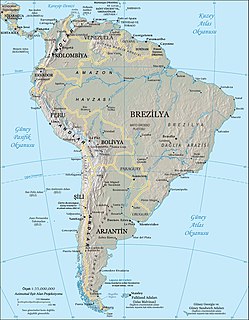
Caviomorpha is the rodent infraorder or parvorder that unites all New World hystricognaths. It is supported by both fossil and molecular evidence. The Caviomorpha was for a time considered to be a separate order outside the Rodentia, but is now accepted as a genuine part of the rodents. Caviomorphs include the extinct Heptaxodontidae and extant families of chinchilla rats, hutias, guinea pigs and the capybara, chinchillas and viscachas, tuco-tucos, agoutis, pacas, pacaranas, spiny rats, New World porcupines, coypu and octodonts.

A tuco-tuco is a neotropical rodent in the family Ctenomyidae. Tuco-tucos belong to the only living genus of the family Ctenomyidae, Ctenomys, but they include approximately 60 different species. The common name, "tuco-tuco" comes from the "tuc-tuc" sound they make while they dig their burrows.

The Brazilian tuco-tuco is a tuco-tuco species from South America. It is found mainly in the state of Minas Gerais in southeastern Brazil, though Charles Darwin mentions it during his trip through present-day Uruguay.
Oligoryzomys chacoensis, also known as the Chacoan colilargo or Chacoan pygmy rice rat, is a rodent species from South America. It is found in the Gran Chaco region of southeastern Bolivia, southwestern Brazil, Paraguay, and northeastern Argentina. Its karyotype has 2n = 58 and FNa = 74.

Oligoryzomys nigripes, also known as the black-footed colilargo or the black-footed pygmy rice rat, is a rodent in the genus Oligoryzomys of family Cricetidae. Oligoryzomys nigripes is a species that has been further divided into different sister taxa throughout history. It is found in different countries in South America. It is a large species with long ears, dark yellow to dark brown upperparts, sharply delimited from the whitish underparts, and often a pink girdle on the chest. This species of rat spends much of its life among the trees. The karyotype is 2n = 62, FNa = 78–82.

The Jaliscan cotton rat or Mexican cotton rat is a species of rodent in the family Cricetidae. It is found only in Mexico. They commonly have brown fur with white fur on the belly. They are ground-dwelling and prefer open habitats.

The southern tuco-tuco is a species of rodent in the family Ctenomyidae. It is endemic to Argentina.
The reddish tuco-tuco is a species of rodent in the family Ctenomyidae. Five subspecies have been recognized, some formerly designated as separate species. It is found in Argentina and Bolivia at altitudes from 600 to 4,500. This tuco-tuco is fossorial, like others in its genus. Its diet consists of underground tubers and roots. Its karyotype has 2n = 52 and FN = 78.
The Mendoza tuco-tuco is a species of rodent in the family Ctenomyidae.

The Talas tuco-tuco is a species of tuco-tuco endemic to eastern Argentina.

Hantavirus pulmonary syndrome (HPS) is one of two potentially fatal syndromes of zoonotic origin caused by species of hantavirus. These include Black Creek Canal virus (BCCV), New York orthohantavirus (NYV), Monongahela virus (MGLV), Sin Nombre orthohantavirus (SNV), and certain other members of hantavirus genera that are native to the United States and Canada.
Ctenomys andersoni, also called Anderson's cujuchi, is a species of tuco-tuco native to Bolivia. Found only in Cerro Itahuaticua, Department of Santa Cruz, at an elevation of around 810 metres (2,700 ft), the species measures 271 millimetres in length and has coarse brown and grey hair. It was named after Sydney Anderson, curator of the Department of Mammalogy at the American Museum of Natural History.
Erika's tuco-tuco, is a species of tuco-tuco native to Bolivia. Found only in the Cordillera Oriental mountain ranges in the Santa Cruz and Chuquisaca Departments, at elevations of around 810 to 1,800 metres, the species measures around 287 millimetres in length and has soft brown and ochraceous orange hair. It was named after Erika Cuéllar, a conservation biologist from Bolivia.
Lessa's Tuco-Tuco is a species of tuco-tuco native to Bolivia. Only found near Lluthu Pampa, Cochabamba Department, at elevations of around 2,500 to 2,750 meters, the species measures about 255 millimeters in length and has soft brown hair. It was named after Dr. Enrique P. Lessa.
Ctenomys yatesi, also called Yates' tuco-tuco, is a species of tuco-tuco native to Bolivia. Only found near Roboré, Department of Santa Cruz, at an elevation of around 550 metres (1,800 ft), the species measures about 220 millimetres in length and has soft hazel and grey hair. It was named after Terry Yates, a former curator at the University of New Mexico.
The Museum of Southwestern Biology (MSB) is a research and teaching facility in the Department of Biology of the University of New Mexico (UNM). The museum's collections include vascular plants, invertebrates and vertebrates from the American West, Central and South America, and from throughout the world. It is open to visitors by appointment.

Yates's big-eared bat is a species of leaf-nosed bat found in Bolivia.








